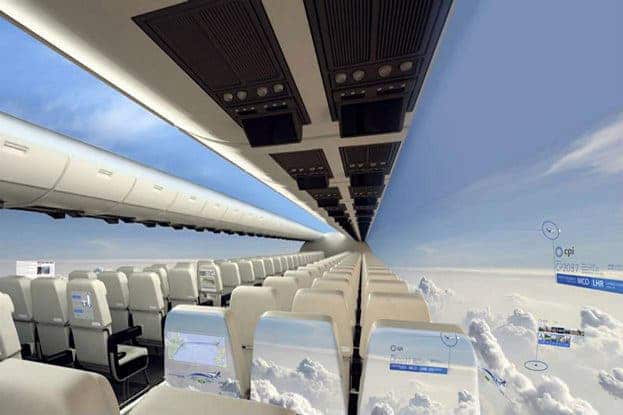An UK design firm is proposing a most daring idea: replace the windows in a plane with super-light smartscreen panel made from organic LEDs (OLED). These panels would cover most of the plane’s inner surface and display the view from outside, better and lovelier than any windows could. Of course, you could choose to watch a football match, read a book or just leave the screen blank – it’s your choice.

Of course, this is not just a design fad – these are rarely allowed through in the aerospace industry where even the slightest tweak can end up increasing a plane’s cost by the millions. On the contrary, the idea is most utilitarian in nature.
For a plane to support passenger windows, the whole fuselage needs to be re-enforced because of the high stresses around the hollow window geometry. If these were removed, then the plane could be built with far lighter materials, cutting down manufacturing costs and, most importantly, operational costs. According to the Centre for Process Innovation (CPI) – the company behind the smartscreen alternative to plane windows – for every 1% reduction in the weight of an aircraft, there is a saving in fuel of 0.75%.
“We had been speaking to people in aerospace and we understood that there was this need to take weight out of aircraft,” said Dr Jon Helliwell of the CPI.
“Follow the logical thought through. Let’s take all the windows out – that’s what they do in cargo aircraft – what are the passengers going to do? If you think about it, it’s only really the people that are sitting next to windows that will suffer.”
Helliwell and colleagues have actually thought of a better alternative to the windows by proposing screens that would be made using organic light-emitting diodes (OLEDs) – a combination of materials that give out their own light when activated by electricity. OLEDs are very expensive today and, worst of all, are very sensitive to moisture and require a special casing. This means they’re generally inflexible and hard to adapt for this kind of project.
“What would be great would be to make devices based on OLEDs that are flexible. We can make transistors that are flexible but if we can make OLEDs that are flexible, that gives us a lot of potential in the market because we can print OLEDs on to packaging, we can create flexible displays,” he said.
Using £35m worth of advanced equipment in its Sedgefield facility, the CPI says it working on technologies to advance flexible OLEDs and tackle problems of cost and durability. The team hopes it can develop technology that will enable the company to advance this concept in the next 10 years. The video below showcases how this might look like.


